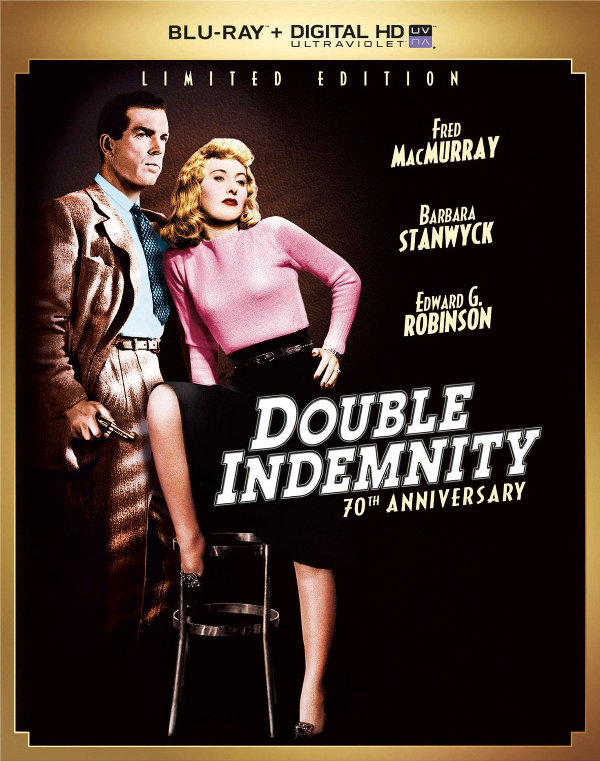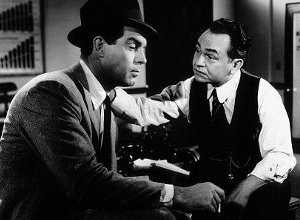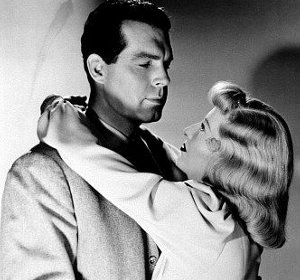- Title: Double Indemnity
- IMDB: link

 It wasn’t the first film in the genre that would come to be known as film moir, but it’s one of the best. Directed by Billy Wilder, who co-wrote the film with Raymond Chandler (The Big Sleep, The Long Goodbye), Double Indemnity is often referred to as “the paradigmatic film noir,” raising the bar and setting the standard for all others that followed.
It wasn’t the first film in the genre that would come to be known as film moir, but it’s one of the best. Directed by Billy Wilder, who co-wrote the film with Raymond Chandler (The Big Sleep, The Long Goodbye), Double Indemnity is often referred to as “the paradigmatic film noir,” raising the bar and setting the standard for all others that followed.
Our story begins with Walter Neff (Fred MacMurray), a cocky insurance salesman bleeding out in his boss’ office of a gunshot wound while recording his confession on Dictaphone. Through Neff’s narration the events which led him to this gruesome end are slowly revealed.
A simple house call to get his client to renew his auto insurance becomes anything but when Neff falls hard for the man’s younger wife (Barbara Stanwyck) who, at their first meeting, suggests procuring accidental life insurance for her husband (Tom Powers), without his knowledge.
Neff immediately knows what the woman is implying and promptly leaves. The story might end there, but despite knowing exactly what Phyllis Dietrichson is after, Neff finds himself seduced, caught in the spider’s web, and eventually comes to agree to push through the policy and help her kill her husband. With his knowledge of police procedure and insurance investigation he’s sure he can plan the perfect murder and sail away into the sunset with his new girl with the $50,000 payout on the double indemnity policy to split between them.
Despite being racy for the time, the script languished for eight years over the Motion Picture Production Code’s objection to the “sordid nature” of the story, it found immediate and lasting critical praise. Double Indemnity was nominated for seven Academy Awards. It may have left the ceremony without any wins, but it would leave an indelible mark on the genre it helped create and is widely regarded as one of the best American films ever made (ranking #29 on AFI’s 2007 list).
 All the marks of great noir are to be found within each frame of Wilder’s film. Wilder and Chandler’s adaptation of James M. Cain’s 1935 novella of the same title keeps the hardboiled nature of the source material while adding a cinematic flair to the events. John F. Seitz‘s black and white camera work help set the standard with the film’s use of shadows and Chiaroscuro photographic techniques that obscure parts of a character’s face, often threatening to swallow up the characters who are only lit by slices of light, often at odd angles through Venetian blinds or other obstructions.
All the marks of great noir are to be found within each frame of Wilder’s film. Wilder and Chandler’s adaptation of James M. Cain’s 1935 novella of the same title keeps the hardboiled nature of the source material while adding a cinematic flair to the events. John F. Seitz‘s black and white camera work help set the standard with the film’s use of shadows and Chiaroscuro photographic techniques that obscure parts of a character’s face, often threatening to swallow up the characters who are only lit by slices of light, often at odd angles through Venetian blinds or other obstructions.
As in many noir tales our protagonist is neither hero nor villain, but a man tempted by a woman into undertaking a crime that beforehand he would have never have considered. Stanwyck’s portrayal of Phyllis Dietrichson set the mold for the femme-fatale whose overt sexuality helps manipulate the men who she bends to her will while hiding, at least for a little while, her innate coldness and cruelty. Common noir themes of jealousy, greed, moral ambiguity, and a pessimistic world view shown through the eyes of an embittered man realizing the truth of his circumstances far too late are all included as well.
The casting of MacMurray is a stroke of both luck and genius. Several of Hollywood’s top stars passed on the role including James Cagney and Spencer Tracy. Their loss was our gain. MacMurray, know best for his roles as all-around good guys in light-hearted comedies, is perfect for the role as his version of Neff is someone whose actions we can abhor while still feeling sorry for the situation he becomes trapped in, despite knowing he’s done it all to himself.
 Although the film rises and falls on the performances of the film’s two leads there are a pair of supporting performances worthy of note. Despite his reluctance to take a supporting role, Edward G. Robinson is perfect as Neff’s boss and friend whose job it is to investigate the mysterious death of Dietrichson. MacMurray and Robinson have some terrific scenes together which ramp up the tension as Neff fears his friend may have deduced far more about the crime than he’s letting on. Jean Heather also has a small but noteworthy performance as Dietrichson’s distraught young daughter who doesn’t trust her stepmother and could ruin everything for Neff with a single word.
Although the film rises and falls on the performances of the film’s two leads there are a pair of supporting performances worthy of note. Despite his reluctance to take a supporting role, Edward G. Robinson is perfect as Neff’s boss and friend whose job it is to investigate the mysterious death of Dietrichson. MacMurray and Robinson have some terrific scenes together which ramp up the tension as Neff fears his friend may have deduced far more about the crime than he’s letting on. Jean Heather also has a small but noteworthy performance as Dietrichson’s distraught young daughter who doesn’t trust her stepmother and could ruin everything for Neff with a single word.
Terrifically shot, directed, and performed Double Indemnity is a classic in every sense of the word. Despite telling us the outcome in the film’s opening scene, as noir films often do, the tension of the sequences, particularly involving the murder itself, is palpable. With the end of the summer blockbuster season, and a few weeks before the slow roll-out of Oscar contenders, this is a perfect time for moviegoers to spend some time at home with terrific older films like this one.
The new 70th Anniversary Blu-ray has many of the same extras of the previously released Universal 100th Anniversary single-disc Blu-ray and two-disc Universal Legacy Series DVD including “Shadows of Suspense” (a 37min. documentary on the film and the birth of film noir), an introduction by Robert Osborne, audio commentary by film historian Richard Schickel and a second commentary track from screenwriter Lem Dobbs and film historian Nick Redman, the 1973 remake of the film done for television starring Richard Crenna and Samantha Eggar, and the movie’s trailer. The new set also includes a digital copy of the movie, and alternate ending, and a memorabilia packet including post cards and a small post-card-sized version of the film’s original poster.
[Universal Studios, Blu-ray $29.98]

I’m old enough to remember seeing this in the theater. It’s a great movie and I’ve owned it on dvd for years. Hopefully more people will watch it and see how many films borrowed stories and characters from it.
Those who haven’t seen this movie need to put in in their Netflix queue.